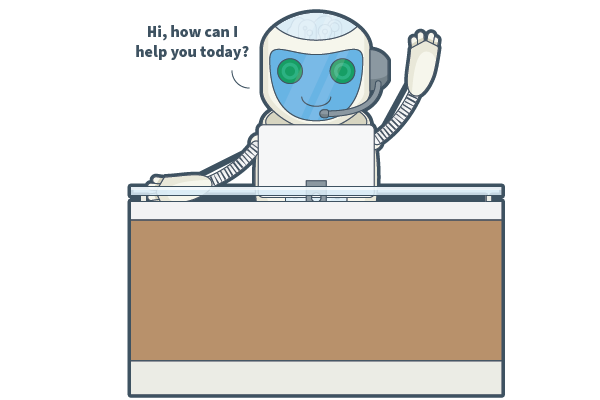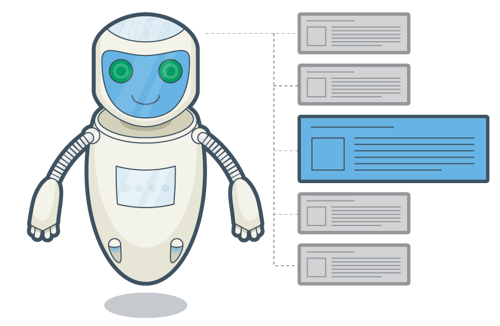EV Blog
Loïc Besnard | April 30, 2020
15 Ways Chatbots for Employees Can Improve the Remote Work Experience
Chatbots: since the invention of instant messaging, they have been present in our daily lives in one form or another. So how can organizations take advantage of this technology to empower their employees and help them be more productive?
Gartner predicts that “by 2022, 70% of white-collar workers will interact with conversational platforms on a daily basis.” Gartner also notes that “This expected growth is on par with the increase of millennials in the workplace.”
There are several benefits of using a chatbot for customers, including the reduction of call time and overall ease of access to knowledge. But what seems to be a largely ignored discussion are the benefits of chatbots for employees. These benefits ultimately result in a better overall remote and blended workforce experience and on the company side, a higher level of employee retention and productivity.
With self-service becoming a staple in creating a positive employee experience, chatbots can push the initiative even further.
What are Chatbots for Internal Employees?
Before we discuss what a chatbot is, we should note what a chatbot is not. A chatbot is not an all-knowing robot who plans to take over the world. A chatbot is not a machine invented to take the worker’s job. And importantly, a chatbot is not a program created to challenge and remove all human interaction. Feeling better about chatbots yet?
In simple terms, a chatbot is an automated program that simulates human conversation, or “chatter”… hence the name: chatbot. These bots are typically found in the form of instant messaging (IM) platforms which can be used to help with everything from technical support to creating a ticket with the help desk. These bots can also be integrated with several other platforms, like Microsoft Teams, knowledge bases, and websites.
Chatbots can work in different ways, but all chatbots use a programmed set of rules. Chatbots for employees or even for the service desk differ from customer-facing bots because of the rules programmed into them. For example, employees may have access to a far more expansive knowledge base than customers, and therefore a chatbot for an employee may provide far more assistance than you might typically find on a customer-facing website.
Read more about how chatbots work and how they can provide support for your service desk here.
How Can Chatbots Improve the Employee Experience?
We know that chatbots for customers can do everything from reducing the number of calls to support agents, to improving the overall customer experience. But when it comes to chatbots for employees, what is the big deal?
You might be thinking “great, another app to manage, why should I try to use a chatbot with my remote team?”
Before dismissing chatbots as an unnecessary addition, let’s discuss 15 ways that chatbots can improve the employee experience and make your remote team want to stay for the long-haul.
Way #1: Accelerate the On-Boarding Experience
The first day of any new job can be overwhelming. Mountains of paperwork with complicated documents, training manuals, and other HR-related tasks may stand in the way of your employee getting to dive into the work at hand. Not to mention the time required of seasoned team members who are needed to answer questions during on-boarding.
However, with a chatbot, a new hire can ask common questions and find answers quickly on everything from filling out tax documents to locating company policies. The bot can also walk employees through on-boarding step-by-step. If the new hire needs access to a specific platform, a chatbot can help guide them to that access without involving the IT service desk.
Way #2: Provide Access to Ongoing Support
A remote workforce has the unique challenge of timing, which might not be an issue with an on-site staff. Employees may not be working their strict 9 to 5 schedule, which means they may be running into errors at odd hours of the day or night. When the rest of the team is snoozing, a chatbot can answer questions 24/7 by accessing stored knowledge across the organization. You can say goodbye to the mountain of emails with questions in the morning and delayed projects as the employee waits for your response, and hello to a more streamlined process.
Way #3: Access Information and Knowledge Spread Across Various Channels
Providing an omnichannel experience to your employees can be the difference between frustration and satisfaction – but combining these channels also means the knowledge may be spread. Chatbots can easily access information and knowledge spread across channels, leading to a more cohesive omnichannel experience.
Way #4: Automate Workflows
We all know the benefits of a solid automated workflow. Productivity increases and employees are less bogged down with tasks. Chatbots can help create automated workflows which can guide the internal teams through anything from helping customers to getting approval needed from other departments or teams while working on projects. This leads to an overall boost in productivity (not to mention morale!).
Way #5: Create a Consistent Experience Between Departments
There is nothing more frustrating than when departments have inconsistent information, processes, or even knowledge of what other teams do. However, chatbots for employees create a more cohesive experience between departments and teams. For example, a chatbot will access one knowledge database and help employees gain the same answer, whereas traditional communication may have meant that the service team and the accounting team, for example, had different understandings of the same issue.
Way #6: Improve Person-to-Person Interaction When Teleworking
When an employee is attempting to relay a confusing issue, it can get complicated. For example, if an employee is trying to get help with their computer making a funny sound during start-up – they may have a hard time fully explaining this to the support desk. However, a chatbot can help get a better grasp, and record the findings, before getting another employee involved. Suddenly, the funny sound at start-up is identified by the chatbot as a disk error, which is communicated to the support desk and in-turn, the issue is resolved more quickly.
Way #7: Reinforce the Company Culture
When an employee asks a question of a chatbot, the language programmed can help subtly reinforce the language or culture of the overall company. This is especially important in a remote environment, where culture is harder to broadcast. To establish a positive company culture, you must first use positive language. To establish a culture of collaboration, a chatbot can help aggregate ideas and reinforce the type of work environment you hope to establish.
Way #8: Offer Coaching and Answer Questions
We have all been there: you are having an off-day and can’t recall something a coworker explained in the past. Rather than bothering the coworker for the answer, a chatbot can come to the rescue. Similarly, if an employee has a question they may feel uncomfortable posing of a manager, for example, if they would like to know the long-term leave policy but do not feel comfortable discussing it with a manager quite yet, a chatbot can help deliver that information as well. You can also utilize a chatbot to deliver automated feedback, which can help improve productivity and efficiency.

Way #9: Enhance Employees' Ability to Contact IT Service Desk for Support
Chatbots used specifically to reach the IT service desk can empower employees in a number of ways and can ultimately lead to a reduction in the amount of simple, repetitive tasks being handled by the service desk. Not to mention the natural shift-left that can happen with a little help from our bot friends. Employees can ask the chatbot how to handle a technical challenge on their own, and when necessary it can create a ticket for the help desk. Chatbots can also help categorize and prioritize tickets, as well as create automated resolution. All of this can send your remote team to the right people at the right time.
Way #10: Empower Employees with Lightning-Fast Actions at Their Fingertips
Chatbots for employees can take tasks that may have once required several separate tasks and condense them into one step. For example, an employee searching for a file in a shared drive may have to take several steps before they can begin working. They must remember where the file is stored, search in a potentially cluttered folder, find the most recent document, launch Word, and wait. However, with a chatbot in place, the employee can simply type “Open X document where I left off,” or even simply ask “Where is X file saved?” which removes several steps.
Way #11: Suggest Training and Skill Development
Studies have shown that ongoing training and skill development results in a reduction of staff turnover and an increase in job satisfaction. Offering skill development also reinforces the drive to learn more. But how do you do this, especially if you have a large team? Chatbots. You can invite and guide employees through development opportunities with the help of a bot, which can lead to a major morale – and skill – boost.
Way #12: Push Information to Employees
Email used to be the fastest way to spread information to the entire team quickly. But with the increase in emails comes a higher likelihood that your important employee memo is buried under dozens or possibly hundreds of other requests. However, a chatbot with push notifications enabled can quickly send messages to all of the employees who need to know the information quickly. It provides the instant gratification of a phone call while keeping information in-writing, which is one thing we all love about email.
Way #13: Simplify the Recruiting Process
The recruiting process can be tedious. There is the matter of gathering resumes, choosing applicants, answering applicant queries, and getting valuable insights into the type of applicant. This can be time consuming for the HR team. However, a chatbot can simplify these steps. An external bot can answer applicant questions, while an internal bot can help sort and store applications and provide those necessary insights. This leads to higher levels of satisfaction from the applicants and HR team alike.
Way #14: Alleviate Pressure on Teams Who Are Inundated with Requests
Especially in a remote workforce, teams like the IT service desk, HR, and customer support may be inundated with requests. Rather than allowing emails, calls, and tickets to pile up, a chatbot can answer many questions and guide the user through self-service. This can lead to an overall reduction in pressure to the organization as a whole, which leads to lower staff turnover. Although some interaction will always be necessary, enabling staff to problem-solve with the help of intelligent AI can greatly improve the overall workload.
Way #15: Enable Users to Access Knowledge Remotely, No Matter How They Ask the Question
Most of us have seen chatbots that use natural language processing (NLP). Perhaps it was when you attempted to talk to Siri or Alexa, or when you were a teenager playing with chatbots on IM platforms – either way the goal of NLP is to understand user requests in the form of free speech or language. This is especially important in a remote workforce because different people from different regions may ask questions, well… differently! However, a bot with NLP can help remote workers access knowledge from any location, asked in any form. It can remove the frustration of feeling misunderstood and lead to overall improved job satisfaction.
Don’t Forget A’Bot It!
Chatbots are something you won’t want to forget a’bot, especially in the new remote work paradigm. However, it is important that your chatbot works as a complimentary channel to your enterprise tools and platforms so that it can improve support and provide employees with a consistent and interactive user experience. When used properly, the chatbot will become an important member of your remote team.
Learn more about how you can integrate this advanced AI technology like chatbots and knowledge management to elevate the user experience in your organization, click here.
Subscribe to Email Updates
Loïc Besnard
Loïc Besnard serves as Senior Director of Product Marketing and Head Technical Evangelist at EasyVista. Besnard served as Global Pre-Sales Director of EasyVista until January 2017. He joined EasyVista in 2009 and is responsible for EasyVista’s worldwide pre-sales engineering strategy. With over 15 years of experience in the IT industry and international technical sales, Besnard supports EasyVista’s growth, international development and technical sales operations.





